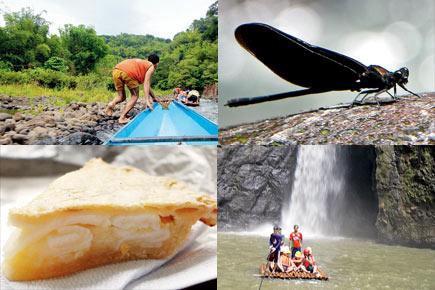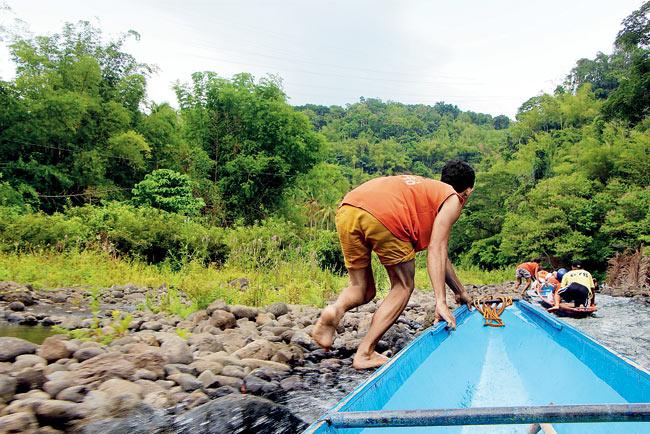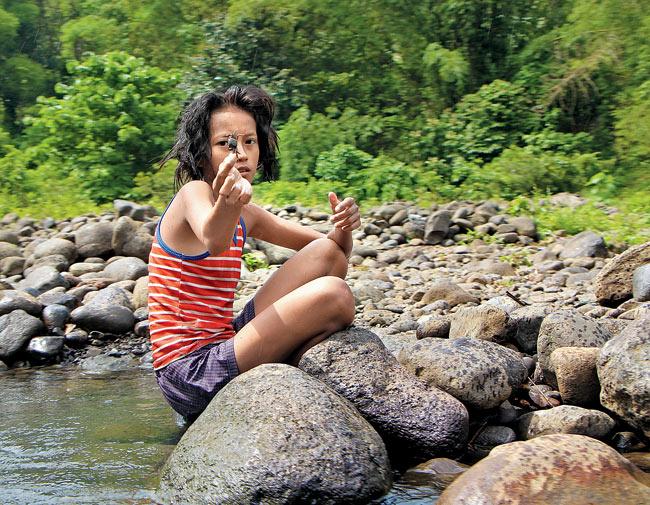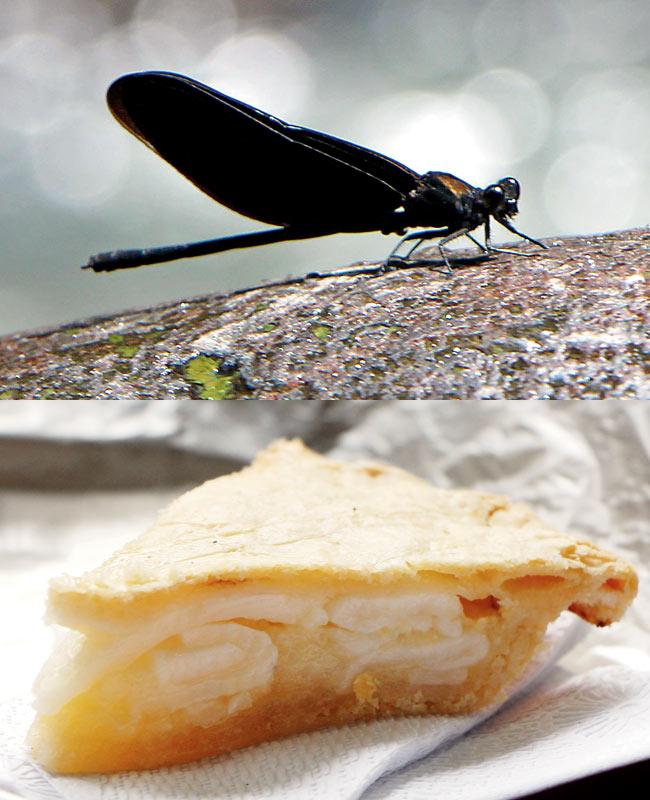A thirst for the dramatic takes Sonia Nazareth down the Pagsanjan River in a canoe. She steps out of her comfort zone and takes a plunge as the waterfall roars around her, only to resurface feeling lighter

Pagsanjan River, Philippines, Waterfalls, Forests, Travel Special
Most travellers I meet are happy to trade the vanilla comfort and safety of resort and spa holidays — for something more adventurous. Drive two-and-a-half hours south of the Philippines’s bustling capital city of Manila — past the gourmet restaurants and fish spas, rocking nightclubs and litany of malls — and you’re in that other Eden.

A boatman maneuvers a canoe at Pagsanjan
ADVERTISEMENT
The transformation of the landscape as we draw nearer to Pagsanjan falls is as dramatic as it is sudden. Even without a guide, one can identify spots where certain scenes of Francis Ford Coppola’s epic war movie, Apocalypse Now, was filmed, along a stretch of the Pagsanjan River. The river as we come upon it is swamped with blue-green reflections, the accompanying forest, trailing leafy fingers in the current. A monitor lizard, still and gnarled as driftwood, watches from a safe distance as we climb into the dug-out canoes in pairs of two and don our life jackets. The water gushes along with a great exclamatory song, strong and harmonious. It’s easy to see why odes have been penned to the landscape since the Spanish colonial era, the oldest account on the Pagsanjan River being written in 1894.

A local shows off a water bug. Pics/Sonia Nazareth
Nature has long been valourised, but as significant is the human skill and ingenuity that makes a journey here possible. The boatmen, with their arms of steel from years of rowing, carry us assuredly upstream, paddling against the increasing current, tugging our boat forward, or using their feet to propel us past rocks and boulders in areas where the water level runs thin. They do this with the single-minded purposefulness of mafia hit-men. If anyone deserves the customary tip given at the end of a service successfully rendered, it’s these heroes.

A group goes on a raft to brave an ice-cold dip under the waterfall
The more dynamic the current gets, the greater the volume of water that splashes into our little canoe. We are now clearer on why we were told to leave the stuff of everyday life (mobile phones, cameras without protective casing, etc) inside cupboards at the convenience centre of the Riverview Restaurant on the shore.
Nature’s bounty
As river adventures go, this one’s clearly five-star. Cliffs adorned with wild tropical vines and ferns engulf us. Beetles, butterflies and birds play hide-and-seek around us further through the gorge. We make as many digital photographs as would garland several village homes. A kingfisher here, butterflies there, dragonflies with incandescent blue-and-turquoise wings when opened and entirely black when shut, everywhere. That the banks are free of the cloned monopolies of malls and amusement parks and are sprinkled with tiny village homes adds heart to the journey.

(Top) A butterfly and (above) Buko or Tender Coconut Pie, a local dessert
We pass a woman washing her clothes in a stream. Her daughter holds up an unusual beetle. Her brothers are splashing about, laughing. These children of an astonishing geography are clearly wealthy — not in money, but if riches were to be measured in terms of things that matter more such as connection, kindness, laughter and a carefree spirit, these folk are clearly millionaires.
Once the canoes enter the gorge that serves as portal to the falls that cascade down 10 metres, it’s like walking into an adventure strip in a Tintin comic. The boatmen are not exactly loquacious but nearly always wise, with the wisdom that living for years on, by and for the river, fosters. When I hesitate to don a protective helmet and take the bamboo raft journey under the Pagsanjan (Magdapio) waterfalls, which are jetting down with the velocity of an express train, my boatman urges me on with the words, “We pass this way but once.”
Even the more adventurous travellers are momentarily tamed by the cries of adrenalin emitted by those returning on rafts from under these thundering falls. Being kicked out of the safe haven is frequently the best thing that happens to one. I take the plunge. Under the waterfall, water thundering, all around me, drowning out all other sounds, leaving me only with an awareness of ragged breath and a jaggedly-beating heart — I’m reminded once more of the sands of time running through the hourglass. Fifteen minutes later I’m soaking wet there’s sand in my shoes, leaves in my hair and rock particles under my nails. My iPhone appears to be dead from the heady bath it’s taken, but I’ve never felt lighter.
The boatman presses some kalamasy — ground sticky rice cooked with coconut milk, and jambol — shredded cassava cooked with sugar, into my hand. He’s keen that I try his wife’s cooking, perhaps as reward for taking the plunge. The snack is delectable, but more delicious yet is the generosity of these unsung people.
Returning downstream the current does most of the work; it’s a faster, smoother trip. But the people along the river, ensconced in the soft landscape of fields, are savouring life slow. A fisherman waves. A couple of children dive into rock pools for a swim unperturbed. Eden it occurs to me, must be somewhat like this; little to create ripples in the peace, except the odd tourist.
Hungry from all the action, we stop at a river-view restaurant also called Pagsanjan (everything is, in these parts). On picnic-styled tables a feast of salads, fruit and chicken and vegetable adobo. Adobo, for the uninitiated, is a marinade of vinegar, soy sauce and garlic browned in oil. Meat, seafood and vegetables can all be cooked in the marinade, and it’s the welcome mat to any substantial meal in these parts. A group of local singers serenade us as we eat. They sing old English songs, breaking off to devour American-style fried chicken with gusto, but the warmth with which they take song requests is distinctly Filipino.
The appetite created by a morning on the waters is evidently like no other. On our drive back to Manila, the guide, ever eager to please, pauses at Collette’s production unit at San Pablo. Collette’s specialises in Buko pie or tender coconut pie, a customary local dessert. The maestros of the kitchen here have gone beyond the original coconut recipe to create every permutation and combination of the dessert. There are pies with pandan, cassava and pineapple. And if there’s only one of the unusual you wish to try, make sure its Bibingka. Not related to the Goan bebinca at all, this one’s a rice-cake with a sweet spongy melt-in-your-mouth texture.
That night back in Manila, at one of the myriad bars overflowing with beer punters, listening to live music that so characterises a night in these parts, random conversations are struck up. Everyone has a story to share. The history buffs talk fondly of a day spent in Intramuros — the remains of the fortified old city which was the seat of power during Spanish colonial times. The lovers of art and architecture reminisce about a visit to the San Agustin Church — one of the oldest stone churches in the country. The teens giggle over the intimate nature of their interactions with (trained) seals they got close enough to kiss firmly on the mouth at the Manila Ocean Park. But my thoughts lie with the Pagsanjan River, of the raw, unpolluted landscape that has no concern for your preferences or your posts, the houses you own or your bank balance; but flows on, despite, regardless. There amid the birds and the thundering waters, whether plumber or writer, investor or soothsayer, we are all just constituents of the landscape, and as equal, vital and precious.
Fact File
Getting there: There are several one-stop flight options from Mumbai to Manila. From Manila it’s a 97 km south to Pagsanjan
Where to stay: Bayleaf is a mid-range, cheerful and well-serviced hotel located in Intramuros. Wi-fi and breakfast are included in the tariff. Visit www.thebayleaf.com.ph
The luxurious Makati Shangri-La, in the business district is located near malls, bars and restaurants. Visit shangri-la.com/manila/makatishangrila/
 Subscribe today by clicking the link and stay updated with the latest news!" Click here!
Subscribe today by clicking the link and stay updated with the latest news!" Click here!







